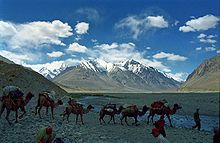Shaksgam Valley
| Shaksgam Valley | ||
|---|---|---|
| location | cashmere | |
| Waters | Shaksgam River | |
| Mountains | Karakoram | |
| Geographical location | 36 ° 6 '33 " N , 76 ° 38' 48" E | |
|
|
||
The Shaksgam Valley , also Shaksgam , is a territory that belongs to China and is claimed by India. It is located in the disputed Kashmir region on the northeast side of the Karakoram . The Shaksgam Valley area includes the upper reaches of the Shaksgam River as well as some side valleys, including the valley of the Sarpo Laggo Glacier on the north side of the K2 .
Political structure

Until 1947 the Shaksgam valley belonged to Kashmir . After the end of British colonial rule in India and the founding of the two successor states India and Pakistan , the dispute over Kashmir arose. Kashmir was divided and the Shaksgam Valley came to Pakistan. In the period that followed, several wars over Kashmir broke out between India and Pakistan. Pakistan tried to win the People's Republic of China, which also claims parts of Kashmir, as an ally and was therefore ready to make territorial concessions to China. As part of the Trans-Karakoram Tract , the border between Pakistan and China was negotiated in 1963 , and the state border has since run across the watershed of the Indus (Indian Ocean) and the Tarim Basin ; The Shaksgam Valley thus belongs entirely to Chinese territory. It is located in Kargilik County and Tajik Tashkorgan Autonomous County in the Kashgar District of the Xinjiang Uyghur Autonomous Region . Pakistan is not making any territorial claims to the area today. It is different with India, which still maintains its claims to the entire territory of the former Kashmir including the Shaksgam valley.
History of discovery and exploration
The first European to tour the Shaksgam Valley was the British officer Francis Younghusband in 1887 . It came from the east from the Yarkant valley over the 4780 m high Aghil pass . By leaving the valley via the side valley of the Sarpo Laggo Glacier and the Eastern Muztagh Pass , he was also the first European to cross the main chain of the Karakoram from north to south. Two years later, Younghusband returned to explore the upper reaches of the Shaksgam. A glacier coming from the Karakoram blocked the valley in full width, followed by another glacier behind it, which Younghusband interpreted as the main source of the Shaksgam River. The weather conditions prevented further penetration and with it the discovery that the source of the Shaksgam River was even further away.

The attempt of the Italian Filippo de Filippi , who in 1909 had already explored the area of the Baltoro Glacier on the south side of the K2 with the Duke of Abruzzo , to explore the Shaksgamtal in 1912, failed because of the flooding of the Yarkant. Like Filippi, the English major Kenneth Mason wanted to reach the Shaksgam Valley from the Karakoram Pass from the south in 1926 . He planned to find the source of the Shaksgam River and follow the valley downstream. The first part of the project was successful, but when several glaciers blocked the valley and had to be bypassed, Mason's expedition reached a similar looking valley parallel to the northeast of the Shaksgam valley. When Mason realized the mistake, it was too late, the supplies were running low, all that was left was the march back. Nevertheless, his exploration into the unknown valley, which he christened Zug Shaksgam ("false Shaksgam"), was not without success, because he was able to measure and map the eight-thousanders of the Gasherbrum group over the west side of the Shaksgam valley .
Individual evidence
- ^ Border agreement between Pakistan and China from 1968 ( Memento of the original from February 11, 2012 in the Internet Archive ) Info: The archive link was automatically inserted and has not yet been checked. Please check the original and archive link according to the instructions and then remove this notice. (PDF; 260 kB)
- ↑ Andreas Schulze, Bernd Neubauer: Through West China to the K2. Expedition to the borderland. Rottach-Egern 1988, p. 55f.
- ↑ Andreas Schulze, Bernd Neubauer: Through West China to the K2. Expedition to the borderland. Rottach-Egern 1988, p. 58f.
- ^ GO Dyhrenfurth: To the third pole. The eight-thousanders on earth. Munich, 1952, p. 235
literature
- Kurt Diemberger: Departure into the unknown. Adventure between K2, Sinkiang and the Amazon. Munich 2007.
- Andreas Schulze, Bernd Neubauer: Through West China to the K2. Expedition to the borderland. Rottach-Egern 1988.
- Rollo Steffens: Fascination Karakoram. The wild mountains of Asia . Bruckmann, Munich 2000.


